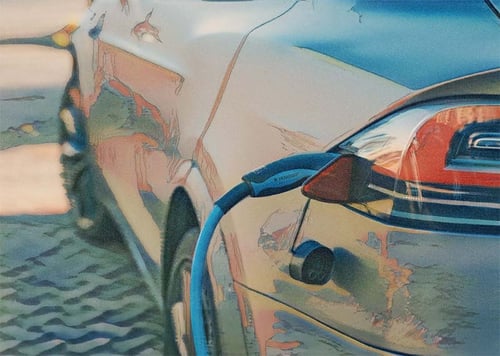
We're closer to affordable electric cars than you think
What do you picture when you think of an electric vehicle (EV)? A luxurious car that is still only accessible to a small part of the European population? Pricetags upwards of € 100.000? God forbid, a cybertruck?
EVs continue to be an expensive part of Europe's green transition, mostly used in the northern parts of our continent. Substantial EU legislation could change that, but only if the car industry follows suit.
A car industry in crisis…
The European car industry is in crisis. At least, that's what the car companies want you to believe. They are sounding the alarm over the bloc's incoming automotive emissions targets, which will require carmakers to replace fossil fuel-powered cars with battery and hybrid electric vehicles (EVs) – or pay hefty penalties. The rules set an emissions reduction path that should eventually lead all new cars and vans to drive carbon-free by 2035. Ultimately, the EU plans to be net zero by 2050 across many industries.
Citing stagnating EV sales and growing competition from the likes of China's BYD and America's Tesla, automakers are now calling for ”urgent relief measures” and pressing the EU to review – read: loosen – its CO2 targets. Almost all major EU car manufacturers have issued profit warnings for 2024, and Volkswagen has even threatened to, for the first time ever, shut down plants in Germany.
… or not?
Thankfully, the doom and gloom narrative of the majority of the European car industry is just that, a narrative. The environmental NGO Transport and Environment (T&E) is having none of it. ”I don't call it a crisis”, Lucien Mathieu, Cars Director at T&E, told The European Correspondent. ”We need to put this into perspective. Europe's six biggest carmakers have been making huge profits, €130 billion in 2022/2023”, and those profits won't stop. The ‘crisis' for the European car industry means that the annual profits are expected to slow down from 10% to some 5% for all EU car makers.
So why the long faces? As far as EV sales are concerned, the ‘crisis' is likely short-lived. The stagnation of EV sales makes sense as the industry adapts to the EU's 2025 targets. Last time the EU introduced new targets for EVs in 2019-2020, carmakers reduced their own supply of EVs in 2019, inflated orders, and as the targets entered into force in 2020, they doubled their sales.
Europe's car industry and other industrial sectors have things to worry about. EU companies continue to pay 2-3 times as much for energy as US competitors, which doesn't make it cheap to transition our production facilities to make EVs. Frantically reviewing our climate targets won't help to ease those issues. Letting more dirty cars on the road for longer won't all of a sudden reduce the energy prices of our industries.
So what would be a better step towards strengthening our car industries? Trick question, the answer is to do nothing – keep the climate policies that the EU passed: ”The best thing you can do to improve competitiveness is to keep the targets rather than removing them”, as Mathieu explains.
”Removing the targets is terrible for investment certainty. There's a lot of investment in EV production and battery production in Europe”, Mathieu continues. ”Let's not change regulations again for such short-term phenomena, but keep the trajectory of the legislation in mind”, adds Eurelectric, the electricity sector association. The targets create an incentive for car, energy, and infrastructure industries to invest in the green transition, optimise the production processes (making them more affordable), and, in the process, strengthen the European EV industry as a whole in the competition against... China.
In the past few years, most debates on the EU's green transition at some stage link back to our dependence on China, be it for affordable EV imports or critical raw materials. Major divisions on a recent vote on imposing tariffs on Chinese-made EVs show how contentious the issue is.
Europe can see Chinese EVs as an opportunity rather than an opponent. ”There have been some irrational debates about the Chinese taking over European car markets. That's not going to happen”, T&E comments. ”European consumers are very attached to European brands”, but more importantly, ”Chinese competition is here, and that's good. It forces us to innovate and improve”.
EVs for everyone
And should all of this even matter to you? Priced at around €40,000, the average EV sold in Europe is too expensive for many households, even though its much lower fuel and maintenance costs make the total price tag roughly comparable to that of a traditional car.
There are signs that Europe's car companies are starting to get the message, as they are expected to launch at least twelve new affordable EV models in the coming years, priced at €25,000 or less.
Interestingly, it's precisely the EU's stringent EV policies and competition from China that drive the car companies to switch gears, forcing them to ditch their strategy of focusing on luxury cars and SUVs to break into the EV market and start offering electric alternatives to lower- and middle-income consumers as well.
There is still much to be done before EVs are an affordable and realistic alternative to combustion-engine cars for all Europeans. In 2022, most cars registered in Sweden and Iceland (58% and 56% respectively) were EVs. In contrast, the number remained below 5% in other Central and Southern European countries like Cyprus, Poland, Czechia, and Slovakia.
However, the EU's plans for electromobility by 2035 also address the geographical divide between the North/West and the rest of the EU. Additional legislation like the Alternative Fuels Infrastructure Act can bridge geographical inequalities by mandating governments to provide more charging stations across Europe, making EVs a more realistic option for long-distance travel.